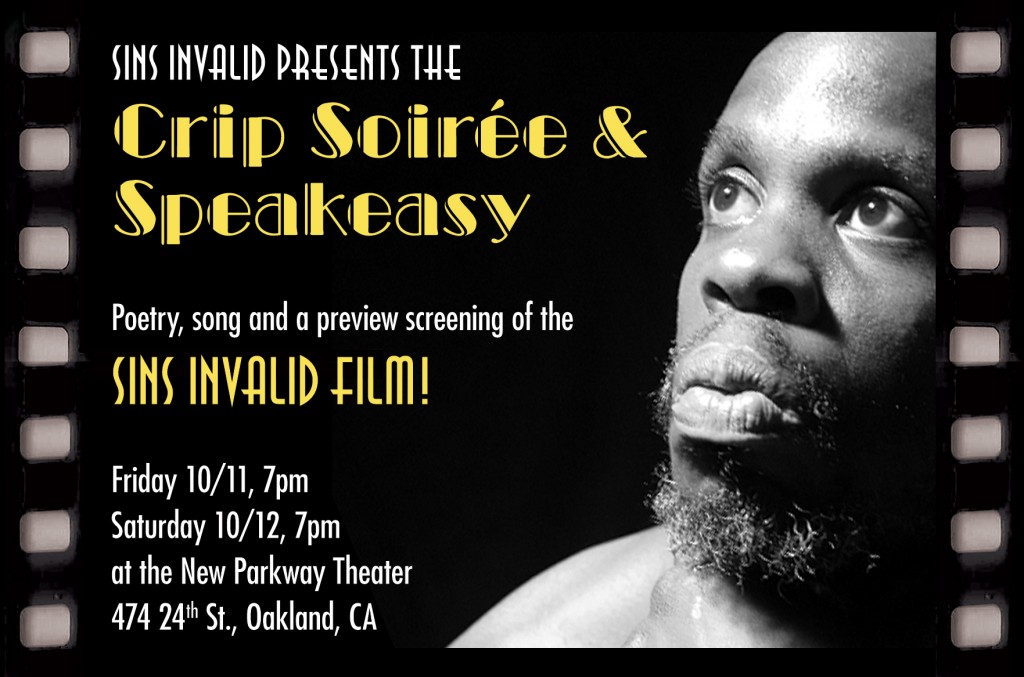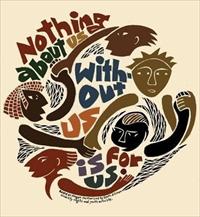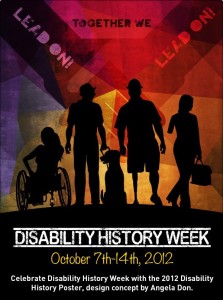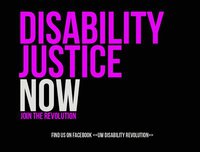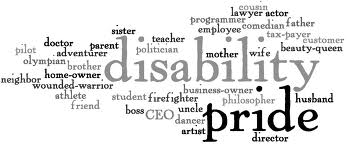I Wonder What They Were Thinking
Last week, I was coming home from a housecleaning job in Live Oak. I’d been working at that job once a week for the past few months, but the people were moving, and they needed me to come and do a final cleanup for them. So I went over there several times, helping them get organized and cleaning up the apartment.
Ordinarily, I’d take the bus to the job and walk the four miles home. I love walking and it’s a nice way to relax after working during the afternoon. But on Friday, I was incredibly tired and I decided to take the bus back.
When I picked up the bus at 4:45, it was crowded and all of the accessible seats were taken. Some of the people using them were clearly disabled; others did not appear disabled, but might have been. My general policy is this: Unless I see someone who is very clearly nondisabled sitting in an accessible seat — such as a young man with a skateboard — I won’t ask the person to get up. I won’t make assumptions. For all I know, a young person who doesn’t give up an accessible seat might have an invisible disability, and I’m not going to question anyone. I pretty much depend on other people’s sense of decency around this issue; if a person doesn’t need the seat, I depend on that person to get up. Often, that works out well for me. Occasionally, it doesn’t. But it’s worth it to me to not question a person as to whether they’re really disabled or not. I’ve had that happen to me too many times to want to run the risk of doing it to someone else.
So I went to the back of the bus, where the aisle is narrower. I had a pull cart with me that had a few very light things in it. The bus driver told me that I couldn’t have the cart blocking the aisle, and that I had to put it in the luggage area at the front of the bus. So I traipsed down the aisle with my cane in one hand and the handle of the cart in the other. I put the cane down, picked up the cart, put it in the luggage rack, picked the cane back up, and went back to my seat.
As I was doing this, I was wondering whether I was confounding people’s expectations of a person using a cane. Were they surprised that I could stand on my feet long enough to pick up a cart and put it in a compartment three feet off the floor? Did they think I was faking disability? I’m not sure. But I was very interested in the contrast with how I used to feel walking through the world with only invisible disabilities. Before I used a cane, I generally had people assuming I was nondisabled and perfectly capable of doing everything in a “normal” way, and I was aware that they were rather shocked to discover that I’m disabled. Now, I generally have people assuming that I am disabled, and I’m always aware that they may be shocked when they see me doing things in a “normal” way.
No one said anything. I didn’t sense anyone giving me the evil eye. But I wonder about it. There is a self-consciousness I feel now that wasn’t there before — a sense that other people might be expecting me to live down to expectations. It’s very odd. Living down to expectations has never been my style. So it gives me a sense of power to just do what I need to do, whether it confounds people or not.
© 2013 by Rachel Cohen-Rottenberg
The Sins Invalid Film: An Interview with Patty Berne and Leroy Moore
[The graphic consists of the face of a Leroy Moore looking upward and to the left. The left and right borders are drawn to look like the perforations in film negatives. Against a black background, the text reads: "Sins Invalid presents the Crip Soiree and Speakeasy. Poetry, song, and a preview of the Sins Invalid film! Friday 10/11, 7 pm, Saturday 10/12, 7 pm, 474 24th St., Oakland, CA."]
Sins Invalid is a performance project on disability and sexuality that makes central the work of queer artists, gender-variant artists, and artists of color. Over the past several years, Sins Invalid has been producing a film about its work. The Sins Invalid film will premiere in Osaka, Japan on September 14 and will be shown thereafter in venues around the US.
This past week, I interviewed two of the co-founders of Sins Invalid, Patty Berne and Leroy Moore, about the film, about their work, and about the ways in which Sins Invalid engages issues of disability, sexuality, and justice.
Rachel: What led you to create the Sins Invalid film?
Leroy: We wanted to get Sins‘ artistic and political vision and work beyond the Bay Area. We know that our community has grown nationally, even internationally, and while there’s nothing like a live performance, we wanted to make ourselves as accessible as possible for non-local community.
Patty: The power of the artists’ work really lays in the visual narratives as well as language. It’s important to see disabled bodies (however one defines that) actually embodying power and grace and sexual agency.
Leroy: There’s nothing like having full control of the context and the message both — and we are able to do that on stage and in many ways in film media as well.
Patty: We are being very thoughtful about where and how the film is shown, attempting to partner with community-based organizations to screen it. We are actually having our world premiere in Osaka Japan in a week!
Rachel: That’s so exciting! What will be the venue in Osaka? Where is the film being shown?
Patty: It will be shown as part of the Kansai Queer Film Festival at HEP Hall in Osaka. They invited me to attend and speak as well. They are interested in intersectionality and the potential for allegiance between those doing queer organizing and disability organizing. I’m specifically going to address relationships between gender justice and disability justice.
As a power chair user, I must admit to being very nervous about the ableist air transportation system. But I think it’s an amazing opportunity for disability justice frameworks to go international and for us to build relationship with queer folks with disabilities in Japan. And, it’s a particular honor for me, as I’m Japanese American. (My mother is from Kamakura and immigrated here in the 1940′s.)
Rachel: I’m glad you’re able to avail yourself of this opportunity. Intersectional discussions that include disability are crucial. As I watched the film, I found myself very interested in the process of how you put it together. When did you begin, and what was the process like as it unfolded?
Leroy: We began the film process in 2007 and have accumulated approximately 100 hours of footage.
Patty: As Leroy said earlier, we decided to document the work as a way to spread our vision and begin these conversations in broader sectors. Film has SUCH a broad reach. And as I said earlier, the visual narratives are as powerful as our language. But we had no idea what we were getting into really! I have so much respect for filmmakers! The medium is resource intensive and relatively unforgiving.
We’ve worked with 3 editors over the course of the 5 years, and finally really clicked with one in the last push toward completion.
Rachel: I’m so impressed both by the quality of the art depicted and by the film itself. It is all so beautifully done. Could you each speak to the ways in which the art of Sins Invalid serves the cause of disability justice, particularly in terms of disability and sexuality?
Patty: Thank you for appreciating the work! We live in a very visual age, where we are inundated, saturated by imagery. But most of that imagery reflects systems of oppression and the violence that supports it, slickly produced and packaged so that we consume it without reflecting on what narratives we are ingesting.
We decided to produce performance with high artistic merit because, as artists, that is important to us, but also because we are aware that disability imagery is perpetually used to reinforce our own oppression — charity programs like the MDA Telethon, the specter of the ghastly cripple as in David Lynch films, the tragic crip who serves the higher purpose through suicide as in Million Dollar Baby…
We need images of the truth — that we are powerful and complex and fucking HOT — not despite our disabilities but because of them!
In any movement, there is a need for artists to reflect the reality of the communities, and I think that’s what we’re doing. It’s also our responsibility to reflect the political imagination for what liberation could look like, so we seek to do that as well.
I think movements need a variety of formations — organizations who organize its base, think tanks and scholars and media, policy makers, cultural workers… And I like to think that Sins is doing that cultural work
We focus on disability and sexuality with in a disability justice framework specifically because sexuality is a human right, yet it is one of the most painful ways that we are dehumanized. We are neutered in the public eye (at least in this national context). We recognize our wholeness — including our lived embodied experience and our sexuality — and want to reflect that wholeness.
Leroy: I wanted to add that typically we see sexuality as something we do individually and privately, and we don’t usually see its impact on community. Sins breaks up the idea that sexuality is just an individual activity but brings sexuality into the conversation as a political issue to include as part of justice work. After all, it’s part of our oppression.
Rachel: Yes. One of the most powerful things about Sins Invalid is that it celebrates that disabled people have a lived experience of the body — that our bodies are not inert or inanimate. Given that human beings live in bodies, showing our lived experience is crucial for asserting our humanity.
With regard to justice work, what are the commonalities that you see in the struggle for social justice among marginalized peoples — particular among people of color, trans* and genderqueer people, disabled people, and queer folk — and how does Sins Invalid speak to these commonalities?
Patty: There are many commonalities and points of distinction. One of the primary commonalities is that a tactic of oppression used against all of us is that the oppression has been inscribed on our very skins — that our oppressions have been naturalized as a by-product of having a particular body — so that people think that what is difficult about being gender non-conforming, for example, is being in a non-conforming body, as opposed to being in a system of gender binary and heteronormativity. Or that what is difficult about being disabled is needing an accommodation, as opposed to living within ableism.
Another point of overlap is that our sexualities have been demonized and seen as vile or dangerous, and used as a way of engendering fear of us. Relatedly, our communities’ reproductive rights have been attacked through eugenic practices and programs.
All of the oppressed communities that you identified — communities of color, disability communities, trans/genderqueer communities, queer communities — we are all living within a white, able-bodied, heteronormative patriarchal capitalist context and struggle daily to live safely, with dignity. We each have struggles specific to our own experience of oppression, certainly, but the various systems of oppression reinforce each other and all manifest into all of our communities.
Leroy: And beyond a shared oppression, all of our communities have a rich culture — arts, music, poetry — and through our creation we can learn about each other and how we have each celebrated our own existences and spoken out against injustice. For example, there is a community of queer black women in the Blues that survived “isms” and created strategies for living and amplifying their artistic voice, and I think all communities can learn from that.
Rachel: I agree. One of the things that I appreciate about the work you do is that you go beyond critique into talking about how life can and must be. Along these lines, what kind of impact do you hope the film will have?
Patty: I think we are hoping for folks with disabilities who may not have thought about themselves as beautiful or sexy to see themselves in our work and to see their beauty. And for folks who may be functionally disabled but did not want to identify themselves as disabled due to stigma to perhaps feel a bit safer in rethinking the rigid line separating disabled from able-bodied. And for folks who love the work to move resources toward disabled artists!
And more deeply, to change the public debate about disability and sexuality so that it is a given that we have sexual agency, and that it is recognized that as people with disabilities we are also black and brown and queer and genderqueer and that we are not trading one identity for another. So that when we have a conversation about disability and sexuality, we are necessarily discussing our need for deinstitutionalization so that we can express our sexuality. So that when we discuss disability, we are necessarily addressing the incarceration of black men and the treatment of disabled prisoners. Does that make sense?
Rachel: Absolutely.
Patty: Our hope is that the film humanizes us — all of us.
Leroy: We hope that it will open doors of the heart and mind about what cultural work can look like, to go beyond identity politics alone to witness the diversity and strength of our communities. We hope that the film will be an educational tool for youth with disabilities, especially youth of color.
I hope that the film contributes to a cultural critique about people with disabilities and how we are represented in the media.
Patty: We are developing a study guide so that people can read articles or poems and have discussions in their own settings reflecting on the film and what it evokes for them.
Rachel: I hope that all of the work you’re doing will get people talking. Where will the film be screened, and where can people purchase a copy?
Leroy: We are trying to get into film festivals around the country and partnering with colleges and community based groups everywhere to get the film out initially. We are new members of New Day Films, who will be supporting our distribution. Pretty soon our film will be available for individual purchase at http://www.newday.com!
And in the Bay Area, folks should come out for our Crip Soiree and Speakeasy on October 11th and 12th at the New Parkway Theater in Oakland. You can get tickets at www.brownpapertickets.com/event/444189.
And if you are in Japan, go to the Kansai Queer Film Festival . Patty will be in Osaka screening the film and discussing our work on Sept. 14th! Sins goes international!
Patty: If anyone is interested in bringing the film to their campus or group, feel free to contact us at info@sinsinvalid.org. Or if you want to purchase an individual copy before New Day has it, drop us a line at info@sinsinvalid.org.
Rachel: Thank you both for taking the time to talk about Sins Invalid. Much success to you!
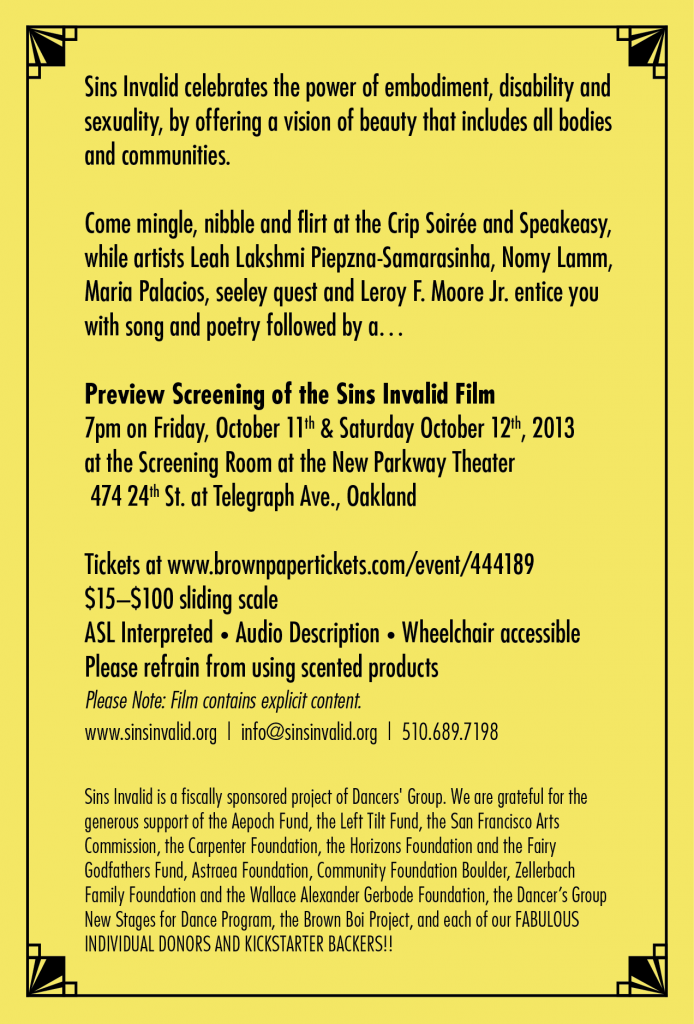 [Against a yellow background bordered by black lines with diamond designs at each corner, the text reads: "Sins Invalid celebrates the power of embodiment, disability and sexuality, by offering a vision of beauty that includes all bodies and communities.
[Against a yellow background bordered by black lines with diamond designs at each corner, the text reads: "Sins Invalid celebrates the power of embodiment, disability and sexuality, by offering a vision of beauty that includes all bodies and communities.
Come mingle, nibble and flirt at the Crip Soiree and Speakeasy, while artists Leah Lakshmi Piepzna-Samarasinha, Nomy Lamm, Maria Palacios, seeley quest and Leroy F. Moore, Jr. entice you with song and poetry following by a...
Preview screening of the Sins Invalid Film
7 pm on Friday, October 11th and Saturday, October 12th, 2013
at the Screening Room at the New Parkway Theater, 474 24th St. at Telegraph Ave., Oakland
Tickets at www.brownpapertickets.com/event/444189, $15-$100 sliding scale
ASL interpreted – Audio Description – Wheelchair accessible
Please refrain from using scented products
Please note: Film contains explicit content.
www.sinsinvalid.org | info@sinsinvalid.org | 510.689.7198
Sins Invalid is a fiscally sponsored project of Dancers' Group. We are grateful for the generous support of the Aepoch Fund, the Left Tilt Fund, the San Francisco Arts Commission, the Carpenter Foundation, the Horizons Foundation and the Fairy Godfathers Fun, Astraea Foundation, Community Foundation Boulder, Zellerbach Family Foundation and the Wallace Alexander Gerbode Foundation, the Dancer's Group New Stages for Dance Program, the Brown Boi Project, and each of our FABULOUS INDIVIDUAL DONORS AND KICKSTARTER BACKERS!!”]
© 2013 by Rachel Cohen-Rottenberg
What It Means To Be A Help Object
I’ve been having a conversation with my friend Julie Rose. Julie has just been diagnosed with Lupus and has become visibly disabled. In response to my piece about disabled people as help objects, she wrote to me and said that she really couldn’t wrap her mind around what being a help object meant until she began to navigate the world with a visible disability. Now she understands it excruciatingly well.
What Julie has to say is so right and so clear that, with her permission, I am sharing it here. She writes:
Before the last few days, I was confused by the term “help object.” It took me less than 48 hours of being a “public cripple” to know what it means.
So far:
1. It means that if you offer me help and I don’t accept it, I’m an ungrateful, ungracious asshole. It doesn’t matter if what you are offering me is useful or not. It doesn’t even matter if what you are offering might be life threatening to me. I must say, “thank you” and accept it with total aplomb.
2. I can’t have a sense of humor. If I do, you will be confused and think I’m fine and feel duped by my asking for help. Therefore, I’m a scam artist, not a cripple.
3. Since I’m home bound, I must have nothing to do and no schedule, so you can barge in on me any time and you can also not show up or call when you have made a commitment to do so. After all, I’ll always be here, in bed, while you are busy with whatever a real life has to offer. I shouldn’t complain. Again, I’d be a whiner or an ungrateful asshole or both.
4. If you don’t follow through with what you promised you’d do, I must still be gracious and say “thank you.” I can’t say it put me out because in your eyes I have no life.
I don’t think I’ve read anything that has made the privilege of Ability quite so clear to me. This level of privilege is stunning. Privilege, in and of itself, isn’t something that one can escape, but it’s something that one can use well or badly. In the kinds of situations that Julie talks about, it’s being used badly.
To use it badly means to treat ill or disabled people as though we belong in some whole other category in which the rules of basic decency do not apply.
Do want to give help? Then ask what help is needed. Do you want to visit? Then ask what a good time might be and show up. Are you wondering how someone can have a sense of humor and be ill at the same time? Stop wondering and start believing.
I fundamentally do not understand why these are such difficult concepts. Do people suddenly lose their rights to be treated like human beings because our bodies change? No. We don’t. Why is this truth so hard to grasp?
© 2013 by Rachel Cohen-Rottenberg
A Rant to My Fellow Activists Who Do Anti-Oppression Work and Ignore Disability
Dear Activists Who Wax Eloquently About The Importance Of Intersectionality In Anti-Oppression Work:
I need to make a request. I’ll try to keep it brief and I’ll do my best to be clear about exactly what I mean.
PLEASE STOP FUCKING IGNORING DISABILITY.
I’ve noticed that many of you complain loudly and vehemently that feminism doesn’t do intersectionality right because it leaves out race, class, LGBT issues, genderqueer issues, religion, ethnicity, and body size. I agree. I completely agree. It’s why I left feminism in disgust some time ago. So imagine my utter fucking surprise when I notice that, oh hell, there is no room for me to agree at all because, as a disabled woman, I haven’t even been invited into the discussion.
I mean, really. It’s provoking to watch you call out feminists for not doing intersectionality right while you leave disabled people out of it altogether. While you keep chanting “race, class, gender” over and over, congratulating yourselves on how inclusive you’re being, you’re leaving out one-fifth of the population.
Disability winds through every other form of oppression. There are disabled people of color, disabled working class people, disabled poor people (lots), disabled LGBT people, disabled genderqueer people, disabled fat people, disabled religious people, disabled people of every ethnicity, and disabled people who experience every form of oppression that human beings can perpetrate. I know the thought that you could become one of us in a millisecond scares the absolute living fuck out of you, but seriously, deal with your fears already because they are not helping us. Start grokking the fact that disabled people are being assaulted, killed, institutionalized, and otherwise having their civil rights violated every goddamned day.
Because in case you haven’t gotten the memo, disability is a civil rights issue.
When people have their children taken away because they’re disabled, it’s a civil rights issue. When people are refused entrance into a restaurant or a theatre or a public park, it’s a civil rights issue. When people are counseled to die rather than live, it’s a civil rights issue. When people are consigned to poverty because of the ways their bodies look and function, it’s a civil rights issue. When people are assaulted, spit on, and killed because they’re disabled, it’s a civil rights issue. When people live in isolation even within communities that talk about oppression and social justice, it’s a civil rights issue.
Every time you fail to acknowledge our presence, it only increase our invisibility. So really, how the hell are we disabled people supposed to join you in doing anti-oppression work if you keep treating us like the embarrassing relative no one talks about?
Allies have one another’s backs. No way in hell am I saying, “I’m your ally, but when it comes time for you to fight for me, I’m on my own.”
Fair is fair.
Reciprocity forever.
In solidarity,
Rachel
© 2013 by Rachel Cohen-Rottenberg
Does My Presence Offend Your White Able-Bodied Male Privilege?
I had several errands to run today. I went to CVS to buy some things for the school supplies drive at the bank. Then, I went to the bank to donate the supplies and deposit a couple of checks. And then I had to mail some paperwork at the post office.
All of my errands went smoothly, everyone I spoke with was very friendly, and I was feeling pretty damned wonderful. And then I got hit with a faceful of entitlement on my way out the post office door.
I was about to walk out the door went I saw a man coming directly toward me. He was white, around the same age as I am, and judging from the determination and speed at which he was walking, physically able-bodied. He was also a big man — over six feet tall and strong. From the way he was walking toward me, it was clear that he assumed that I was just going to get out of his way.
Please bear in mind he was looking at a woman who is 5’1″ and uses a bright red cane. The only way he could have missed either of these things is if he were walking toward me backwards. Which he wasn’t.
Because I am a courteous person, and because I tend to take the long way around people with a lot of attitude, and because it used to be possible for me to make sudden quick movements without risking injury, it’s been my habit to move aside for people like him. But in this case, I instinctively knew that if I tried to get out of his way as quickly as I needed to, I was either going to stumble or I was going to twist myself the wrong way and injure my hip again.
So I just stopped for a moment, made clear my intention to keep going along the same trajectory, and said, “Excuse me.” I figured that he wouldn’t be such a total jerk as to run right into me. And he didn’t. Instead, he audibly sighed, stared me down with a look of utter disgust on his face, shook his head as though I had just committed some sort of unthinkable breach of social ethics, and went around me.
I turned around to look at him, and as he walked away, he was still shaking his head as if to say, “What is the world coming to when an able-bodied white man can’t expect people to get out of his way?”
I was just shocked. I find that I lose my ability to speak in these moments — not because I have nothing to say, but because I am an inveterate problem solver and I know straightaway when problem solving is out of the question. This was one of those moments. The level of privilege that came at me was extreme. He really assumed that the space I was standing in was his, and he didn’t stop for a moment to think, “Wow, that lady is using a cane. Perhaps she might have difficulty moving out of the way. Perhaps she is in pain. I will be gracious and go around her.” Oh, no. God forbid.
As I stood there feeling a combination of powerlessness, shock, anger, and sadness, I realized that I had to say something. Anything. It almost didn’t matter what it was. I was hoping to say something that felt powerful, but all I could do was to shout after him:
WHATEVER.
Oh, God. So not good enough. I mean, it’s okay in a pinch, but I’d like to figure out some brief and effective way to say, “Excuse me, white able-bodied dude. I know you’re not accustomed to the idea that other people have the same right to space as you do, but on most planets THIS BRIGHT RED CANE is a signal that YOU SHOULD BE THE ONE TO MOVE.”
I’m open to suggestions.
© 2013 by Rachel Cohen-Rottenberg
My Body is Not Public Property: The Disability Version
Just a few days ago, I wrote a post about what a blessed relief it is have my cane as a visible marker of disability. After living my whole life with invisible disabilities, I am enjoying the fact that my subjective experience and my outward appearance are in greater harmony. As a highly visual person in a highly visual culture, I’ve found it wearying to navigate the ambiguity of being disabled but not looking disabled. The burden that has been lifted by using a cane has been immense.
One of the benefits of the visible marker is that my disability is right up front. People can either welcome me in or treat me as Other, but I know right away which one it will be. In the past, because I’ve tended to present as “normal” at first meeting, the pattern has been that people had an expectation of my normalcy, then they’d get to know me, then they’d see how atypical I really am, then they’d feel somehow defrauded (I knew you were different, but I didn’t know you were that different!), and then they’d walk away. I can’t tell you how many people over the years have gotten pissed off to my face because I didn’t fulfill their projected image of normalcy. It’s good to have a break from that.
But today, I had an experience of the other side of visible disability: the part where well-meaning people ask about your disability and try to help you not be disabled anymore. I had an interaction this morning that woke me up to how subtly it can happen and how quickly I have to be able to meet it and deflect it.
It’s foggy and cool outside today, and I love walking in this kind of weather, so I got up and out of the apartment early. After I’d run a couple of errands, I saw a guy about my age on the street asking for money. I stopped a minute to give him a couple of dollars. He had grey dredlocks and called himself “an old yogi.” He was very gentle in his manner.
I am always very cognizant of the dynamics of helping people on the street: the class difference, the fact that people are in an extremely vulnerable position, and the fear that they carry of not knowing how someone is going to react to them. So I come from a place of wanting to give respect in equal measure with food or money or clothing, because I figure that respect is in as short a supply as cash. But of course, the class and power divisions are still there, and today, they came back at me through my disability.
As soon as I stopped to give the old yogi money, he began to question me about my cane. The opening salvo was to ask whether I was using it as a temporary measure. The implied question was whether or not I am permanently disabled. I didn’t know how to answer that question, because I don’t know whether the problem with my hip will get better. So I told him that something was going on with my hip and that I wasn’t sure what it was.
All of you with visible disabilities are likely cringing at this point, because you know exactly what’s coming and can see very clearly where I stepped into the big bear trap: a perfect stranger was asking about my body, and I gave him information. I’m not exactly sure why I did. Part of it was that he seemed to be expressing concern and I felt appreciation for it; part of it was that it simply took me by surprise; part of it was that I have this impulse toward truth and accuracy and sometimes don’t keep my truth and accuracy to myself. In this case, in order to protect the boundaries around my own body and psyche, I should have simply said, “I’m not available to talk about my disability.”
But I didn’t. I just didn’t see what was coming until he said, “I was on a cane for awhile.” That’s when I thought, “Uh oh. Here comes the testimonial.” He proceeded to tell me how he did yoga and got off the cane, how the cane was a crutch that keeps your body from getting better, how a cane can become addictive, and how I should spend some money on some yoga classes and see whether I could clear up the problem myself. In other words, using a cane was a Bad Thing, and having a problem with my hip was a Bad Thing, and of course, I wanted advice on how to evade the Bad Thing.
I was really shaken by this interaction. On the one hand, I understand where the guy was coming from. The class division was there and it was complicated by gender: a man was asking for money from a woman. There was a power struggle of sorts, a struggle in which my disability became my point of vulnerability, despite — or perhaps because of — my class privilege. And there was also an emotional struggle, in which the old yogi wanted to feel the dignity of giving back, as a man and as someone in poverty. He didn’t just want to take. He wanted to help me, too. I saw all of that happen, and it’s difficult to feel angry about it, because at the end of the day, he’s still sitting on the street asking for money and I’m in my apartment with plenty of food and safety.
On the other hand: boundaries. In this case, there are two sets of boundaries that got broken. One set consists of the boundaries that ought to keep a man from asking about a woman’s body without knowing her well enough to make the asking appropriate. The other set consists of the boundaries that ought to keep a nondisabled person from asking about a disabled person’s body and offering advice. Leaving aside the gender issue, the message that I got was that the questions and advice about my disability were welcome.
That’s the part that really got me. There was absolutely no consciousness in the interaction that I might love my cane and that its being a crutch is a Good Thing. There is nothing wrong with a crutch if your leg feels unstable and you’d like to go for long walks anyway. There is nothing wrong with a crutch if it keeps you from falling down. There is nothing wrong with a crutch if it communicates that your body works differently from other bodies and that’s okay.
And of course, the questions were all about disability as a purely medical condition. There was no place in the interaction for disability as a social identity, as a source of pride, as something to make visible because it’s part of who you are. I was caught in the same place in which I’ve always been caught as a woman: If you don’t want the attention, why carry yourself with so much pride in your body? Why be so visible? Why ask for it?
And the answer is exactly the same: Being visible is not an invitation to intrusion. A woman who walks down the street in a bikini isn’t asking for leering commentary any more than a disabled person with a cane is asking for help and advice from a stranger. My body is not public property, not an opportunity for personal conversation, not a canvas upon which other people can paint their fears and power needs and good intentions.
Despite today’s interaction, I am not going to hide. In fact, I just purchased a bright red cane to go with my bright red sneakers. For the first time in my life, I want to stand out. For the first time in my life, I know that standing out doesn’t mean I’m asking for intrusion. It just means that I’m taking up my place on the earth just like everyone else.
So please remember: When I stand out, it doesn’t mean I’m asking for your opinion, your commentary, or your help. It means that I’m asking for your respect.
© 2013 by Rachel Cohen-Rottenberg
Making the Invisible Visible: It’s All Right to Stare
In the past few weeks, I’ve been walking with a cane. After about three weeks of painful back spasms in April, everything has calmed down except for my right hip. I’m not in any pain, but my hip aches on and off, and there are times that my right leg feels very unstable. So, instead of walking around gingerly and being fearful of falling, I use a shiny black cane for extra support. The impact on my confidence, my energy level, and my ability to navigate has been immeasurable. I’m taking long walks again, I walk much more energetically, and I come home far less tired than before.
And there is an added bonus: I am relieved beyond words to have a visible marker of disability. There is something that feels seamless about my life now. For my invisible disabilities, I have a series of invisible canes; strategies, adaptations, and self-talk that I use to give myself extra support and confidence in a world that is not made for my body. But no one sees them. Now the cane is on the outside, and I have a visible indicator of what I’ve been doing all my life. Despite the aches and the fact that walking is harder work these days, the visible indicator is a blessed relief.
In the light of all this, I’ve been watching the ways in which I’m interacting with people, and there are some interesting differences. In the past, I’d see a person using a wheelchair and I’d want to somehow communicate that I’m disabled as well, but really, what am I supposed to say? Hi, I’m Rachel and I’m disabled? People just want to get on with their shopping, you know? But now, I notice that I can sink into those interactions in way I couldn’t before. There is a marker that says we share something in common. Not everything. But something. No words are needed. For a moment, there is a glance of recognition, and if you have invisible disabilities, that recognition is a significant experience.
And then there are the stares from nondisabled folk. Oddly enough, I’m getting past my natural shyness. Today I was out walking by the ocean, and a little girl, about ten years old, came by on the back of a tandem bike with her dad. As they passed me on the sidewalk, she turned all the way around to stare — first at me, then at my cane, then at me again, with a look of perplexity verging almost on alarm, as though my cane were a bit scary. I generally don’t like people staring at me; in the past, my response has almost always been defensiveness.
Today, I watched that defensiveness come over me for a moment and then I thought, “No. This is a opportunity to break down this barrier.” So I smiled and waved.
The effect was immediate. Her face completely relaxed and she waved back. And then even after she’d turned around, she kept her arm out to the side and kept on waving at me.
It was a lovely moment to step into.
And then, I was walking back to our apartment, thinking about this interaction, when I saw another little girl of about ten. As the girl and her family were walking down the street, a woman using a wheelchair came toward them and then turned right to go down the sidewalk to Walgreen’s. The little girl craned her neck to watch the woman and her wheelchair roll down the sidewalk. I thought to myself, “How odd! Another little girl staring.” What I didn’t notice until I got closer that the little girl’s legs were bowed and she was walking with a great deal of effort. So what at first glance had looked like a stare of an able-bodied child was the stare of a disabled child watching a disabled adult just go about her life and get things done. There was something lovely about that, too.
For me, at least as far as children are concerned, it’s all right to stare. I’m not sure how I’d feel if I saw adults staring at me, but kids have a natural curiosity and it doesn’t offend me. Of course, I’m new to all of this, and in six months, I might feel differently. But at this point, I’m looking for a bright red cane to go with my bright red Converse High-Tops. I might even find myself a red beret or put red highlights in my hair.
Because I want to make visible what has been invisible all my life. And for now, if people stare, it’s worth it.
© 2013 by Rachel Cohen-Rottenberg

